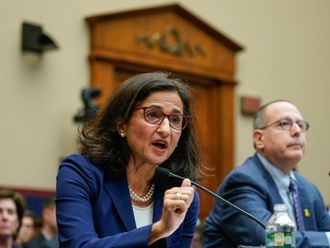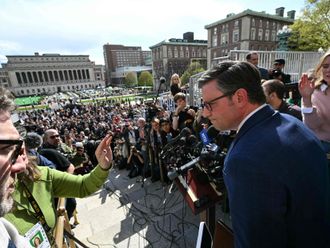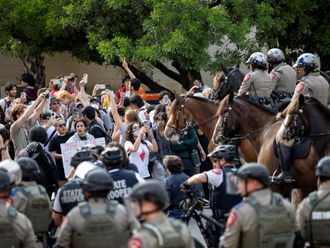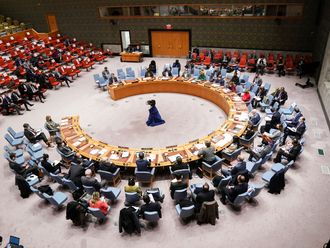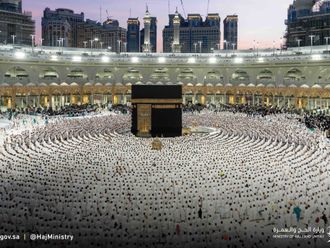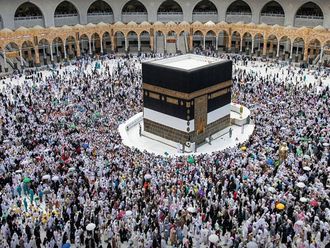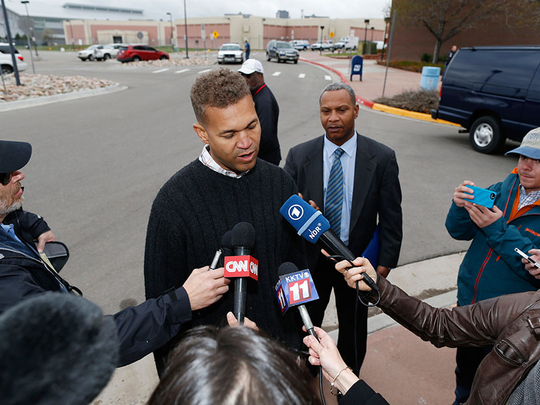
Centennial, Colorado: James E. Holmes sat nearly immobile at the defence table in Division 201 for four hours Monday afternoon as attorneys began their battles to persuade a jury about how and why the promising young scientist became a killer.
Holmes, now 27, is a brilliant and cunning planner, a coward who wrapped himself in protective gear and popped a Vicodin before a 2012 shooting rampage so he could avoid injury as he “tried to murder a theatre full of people to make himself feel better.”
That’s how Arapahoe County District Attorney George Brauchler explained one of the worst mass shootings on American soil during opening statements. Holmes faces 166 charges in the Aurora, Colorado, theatre shooting.
Holmes has acknowledged that he killed 12 moviegoers and wounded 70 others. He was arrested outside the venue with an AR-15 assault-style rifle, a Remington shotgun and a Glock pistol. He had booby-trapped his apartment. But he has pleaded not guilty by reason of insanity.
As victims and family members of the dead listened — occasionally gasping, heads down, sometimes wiping away tears, covering their faces — Brauchler relayed how Holmes weighed the human costs of his deadly actions, which included playing in court a 911 call that night.
“The dead can’t be repaired or come back to life or be normal again; it’s irreversible,” Holmes told a psychiatrist after the rampage in an interview played in court. And the wounded? he was asked. “They’re like collateral damage, I guess.”
That, said public defender Daniel King, was part of the delusional thinking of a deeply sick young man, a victim himself of a different kind of attacker, the latest diseased branch in a family tree filled with full-blown psychosis.
“When James Holmes stepped into that theatre in July 2012, he was insane,” King told the jury. “His mind had been overcome by a disease of the brain that had plagued him for years.
“In his words, ‘I have fought for years to overcome my biology,’” King recounted. “In the end, he lost that struggle with his mind to a disease, a disease called schizophrenia.”
On the first official day of the trial, which Judge Carlos Samour Jr. said could last through September, attorneys played duelling videos in an effort to sway the jurors, who will decide whether Holmes is sent to a mental hospital, prison for life with no chance for parole, or death row.
Brauchler showed a clip of 6-year-old Veronica Moser-Sullivan, pretty in pink, walking past the concession stand at the Century 16 multiplex, en route with her pregnant mother to a midnight screening of The Dark Knight Rises. It was taken from a theatre surveillance camera, the district attorney said, “moments before he shot her four times — four times!”
King played an eerie, black-and-white snippet of a naked, psychotic Holmes months after the shooting in “the rubber room,” running headfirst into the cell wall, bouncing off, collapsing onto the ground.
“Mr Brauchler said he did this for notoriety,” King said. “Look at the video and you tell me if you would do this for the notoriety.”
On Monday, Holmes was neatly sheared and wearing a striped dress shirt, looking nothing like the orange-haired suspect staring wide-eyed out from his 2012 mug shot or the pale wraith in the video. His parents, Arlene and Robert Holmes of San Diego, sat in the audience behind him, looking exhausted and sombre.
Toward the end of his opening statement, as sniffling could be heard in the courtroom, Brauchler talked about how the former neuroscience graduate student booby-trapped his apartment, entered the crowded theatre and then “starts with the shotgun and he begins to pull the trigger.”
“Boom!” Brauchler thundered. “A.J. Boik, who is sitting with his fiancee is shot and killed. Boom! Jesse Childress ... the shot ripped through his heart, lungs and organs and he died.”
Brauchler worked to bring each of the victims to life Monday. He showed their pictures. He named each of the dead and many of the more gravely wounded. He talked about their hopes and dreams, their loves and responsibilities.


